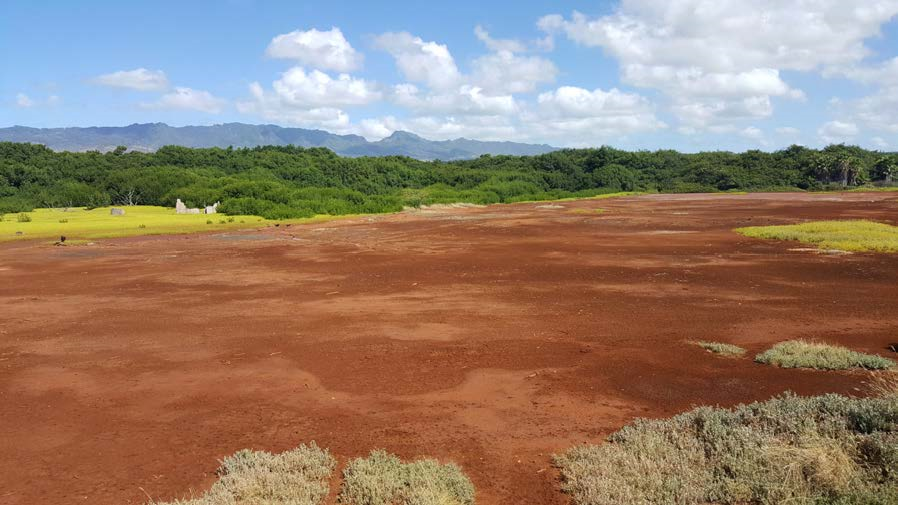Trustees seek public comment on Draft Restoration Plan Addendum/Supplemental Environmental Assessment for the 1996 Chevron Pipeline Oil Spill in Hawaii
July 5, 2022
NOAA and the natural resource Trustees for the Chevron Pipeline Oil Spill of 1996 that occurred near Hawaii’s Pearl Harbor are seeking public comments on a draft restoration plan addendum and supplemental environmental assessment to the final plan that was released in 1999. With this draft plan, the Trustees are proposing to shift some of the remaining settlement funds for the implementation of the Pouhala Marsh Enhancement Project and to cover administration and oversight costs related to the planning of the project. The trustees are seeking public comments on the draft plan and supplemental environmental assessment for 30 days through August 4, 2022.
The proposed shift of funds would pay for the construction of an 8 acre wetland that would enhance the Pouhala Marsh wildlife sanctuary and benefit endangered waterbirds breeding in Oahu. Pouhala Marsh, located adjacent to Pearl Harbor’s west loch, is a 70-acre fish pond and coastal marsh, and the largest remaining wetland in Pearl Harbor. It serves as habitat for native endangered waterbirds, along with several species of migratory shorebirds.
Details on the Proposed Project
The primary goal of the Pouhala Marsh Enhancement Project is to provide habitat for waterbird nesting, foraging and loafing, while recovering wetland habitat, watershed function and native plant communities. Secondarily, the project will continue to foster community involvement and stewardship, and provide educational opportunities to community groups, schools and the general public. The Pouhala Marsh Enhancement Project will be accomplished in two phases, over five years.
Phase I will be the construction of an 8 acre restoration pond. The pond will create a waterbird habitat in an area that does not currently function as a wetland or supports waterbirds. The design will also allow for greater water retention, which would create the ideal habitat for ʻaeʻo (Hawaiian stilt), ʻalae keʻokeʻo (Hawaiian coot), ‘alae ‘ula (Hawaiian moorhen), and other waterbirds that prefer deeper water.
Phase II will be the expansion of available waterbird habitat and wetland ecosystems through community activities. This will be accomplished via monitoring surveys within Pouhala Marsh, as well as performing clearance and maintenance of invasive vegetation using mechanized amphibious machines, in order to provide an optimal habitat for waterbirds.
How to Submit Comments
To submit comments electronically, please send them to Dan Polhemus at dan_polhemus@fws.gov. Please include “Chevron Pearl Harbor Draft Recovery Plan Addendum” in the subject line.
To submit written comments, please mail them to:
Dr. Dan Polhemus
Pacific Islands Fish and Wildlife Office
300 Ala Moana Blvd. Rm. 3-122
Honolulu, HI 96850
All comments should be submitted to the email or mailing address above before the August 4, 2022 comment deadline.
Background on the 1996 Pipeline Spill
At 1:30 a.m. on May 14, 1996, a Chevron Products Company (Chevron) pipeline ruptured at a thin spot caused by external erosion and began discharging No.6 bunker fuel oil adjacent to the Hawaiian Electric Company (HECO) Waiau Power Plant in Pearl City, Oahu, Hawaii. The released oil entered the nearby Waimanu Stream, flowed downstream and entered the East Loch of Pearl Harbor. While in the freshwater of Waimanu Stream, the oil remained mostly submerged and then floated to the surface upon entering the denser salt water of Pearl Harbor.
In Pearl Harbor, the floating oil spread widely around East Loch, fouling shorelines in the process. The spill created a sheen of floating oil throughout East Loch, covering approximately 2,290 acres of open water during the first six days of the spill event. Oiling of shorelines and intertidal areas affected freshwater and saltwater wetlands, mangroves, mudflats, rocky shorelines, sandy beaches, riprap, seawalls and piers as well as recreational use areas in the vicinity.
On September 13, 1999, the Department of Justice entered a Consent Decree valued at 2.25 million to resolve federal and state claims for natural resource damages associated with the spill. The case Trustees will use most of these funds to support this and other restoration projects described in the 1999 final restoration plan.
Download the Draft Restoration Plan and Supplemental Environmental Assessment







